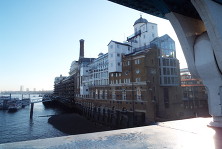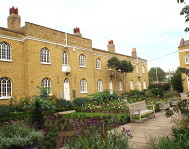








Little Dorrit's Playground
The park is named after the heroine of a book by Charles Dickens. The author had lived in rooms in nearby Lant Street whilst his father was imprisoned in the Marshalsea Prison for debt and had drawn on his own experience for his heroine Little Dorrit who had grown up in the Marshalsea. The Prison had been located nearby, just the other side of Borough High Street and next door to the Church of St George the Martyr which is still known as Little Dorrit’s Church. (The spire of the church can be seen overlooking the park in the photo.)
The Playground was opened in 1902 on an area of land measuring just under a quarter of an acre on some land cleared as part of the Falcon Court Housing Scheme, an area that had previously been home to the worst deprivation, poverty and insanitary conditions. A map of 1896 shows Falcon Court to be have been a warren of small, tightly packed houses and an article in the Standard of January 1894 describes the “rows of houses, generally back to back [that] harbour a population decimated by disease and producing a race of children even more sickly and degenerate than their parents. Child life is in fact blighted, and a plentiful crop of pauperism is provided for the future.” Within a short distance there were 12 large blocks of industrial dwellings that comprised 900 tenements, in total within a very small area there was a population of 4,500. Describing Falcon Court in 1899 when plans were already in hand for its demolition, the investigator for the Charles Booth Poverty Maps described how thieves, bullies (pimps) and prostitutes stood at the Borough High Street end of the Court “spiders to catch flies”.
As early as 1894 the Medical Officer of Health for the St George the Martyr Vestry had called on the London County Council to demolish the area under newly acquired powers and to convert it to a modern recreation ground with some space set aside especially for children. Eventually the slum clearance went ahead. The London County Council paid £5,600 for the land, the land was levelled, drained and tarmacked, and the Little Dorrit Playground was opened on Saturday 25th January 1902.
Over the years, the area of the park increased as houses on the perimeter were demolished. The area was badly damaged by bomb damage in World War Two and in the 1950s the park was still awaiting redevelopment. The tenement blocks surrounding the park were demolished in the 1970s and gradually the area including the park were reconstructed, leading to the further renovation in 2001.
Within the park is a very old looking wall which has a healthy climbing shrub growing along the top of it. Set inside the wall is a specially fabricated iron gate, installed in 2009 and designed by local children. It bears the words “This door was softly opened and these spoken words startled him and came as if they were an answer”, a quote from Little Dorrit.
Little Dorrit’s Playground is a secluded park and children’s play area off Borough High Street which, like it’s near neighbour Red Cross Garden, provides a green oasis away from the bustle of a busy city. Close to two schools in Red Cross Way, it has a modern, well equipped playground which was part of a refurbishment carried out in 2001 through the efforts of the community-led Little Dorrit Park Group and supported by the Bankside Open Spaces Trust.
Web discoveries
- UK Casino Not On Gamstop
- UK Casino Not On Gamstop
- Non Gamstop Casino
- Casinos Not On Gamstop
- Non Gamstop Casinos
- Non Gamstop Casinos
- Non Gamstop Casino
- Casino Sites Not On Gamstop
- Slots Not On Gamstop
- Casinos Not On Gamstop
- UK Betting Sites Not On Gamstop
- UK Casino Not On Gamstop
- Best Non Gamstop Casinos
- Betting Sites
- Non Gamstop Casino Sites UK
- Best Non Gamstop Casinos
- Non Gamstop Casino
- Casinos Not On Gamstop
- Non Gamstop Casino Sites UK